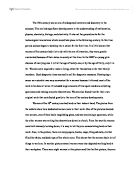The 19th century was an era of widespread invention and discovery in the sciences. This era had significant developments in the understanding of mathematics, physics, chemistry, biology, and electricity. It also set the ground works for the technological innovations which would take place in the following century. In this time period, science began to develop into a career for the first time. It is little known that women of this century had a lot to do with the era of invention; they were greatly overlooked because of their status in society at this time. In the 1800’s a young girls chances of marrying was 1 in 3 at the age of twenty-one, at by the age of thirty, only 1 in 16. Women were required to make a living, either for themselves or for their family members. Such desperate times seemed to call for desperate measures. Developing a career as a scientist was very convenient for a woman because it allowed most of the work to be done at home. It included large amounts of time spent outdoors collecting specimens and making concrete observations. Women also found time for their own original work that contributed greatly to the turn of the century developments.
Women of the 19th century worked hard on their tasks at hand. The photos from the website show how dedicated women were to their work. One of the pictures showed two women, one of them had a magnifying glass, and was examining a specimen, while the other woman was writing the observations down in a book. From the way the women were both intensely looking down, it is easy to tell they are concentrating hard on their work. Also, in the picture, there are many papers, books, maps, filing cabinets, etc that filled the tables, and desk tops of the whole room. This shows that the women had a lot of things to work on. In another picture several women were also depicted working hard at their workplace. There were eight women in this picture and like the first picture; they are all looking down, showing how intensely they are focused on their work. For every woman looking at a specimen through a microscope, there was one woman writing the observations down in a book. In this particular picture it is interesting to note that there is a man standing up, overseeing the work of the women. Since in the picture he is standing behind the women, overseeing their work, I think it is safe to assume, he was the women’s boss. Judging from the blank look on his face, he did not seem like he was paying much attention to the women’s work. Actually, after zooming in on the man’s face, I noticed his eyes were not even on any of the women, he looked like he was staring off into space. These photos show that women were very dedicated to their scientific work, even if their bosses were not.







